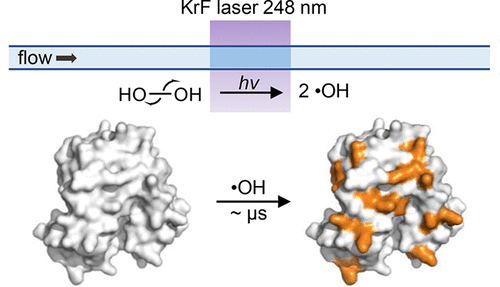当前位置:
X-MOL 学术
›
Acc. Chem. Res.
›
论文详情
Our official English website, www.x-mol.net, welcomes your feedback! (Note: you will need to create a separate account there.)
Mass Spectrometry-Based Fast Photochemical Oxidation of Proteins (FPOP) for Higher Order Structure Characterization
Accounts of Chemical Research ( IF 18.3 ) Pub Date : 2018-02-16 00:00:00 , DOI: 10.1021/acs.accounts.7b00593 Ke Sherry Li 1 , Liuqing Shi 1 , Michael L. Gross 1
Accounts of Chemical Research ( IF 18.3 ) Pub Date : 2018-02-16 00:00:00 , DOI: 10.1021/acs.accounts.7b00593 Ke Sherry Li 1 , Liuqing Shi 1 , Michael L. Gross 1
Affiliation

|
Assessment of protein structure and interaction is crucial for understanding protein structure/function relationships. Compared to high-resolution structural tools, including X-ray crystallography, nuclear magnetic resonance (NMR), and cryo-EM, and traditional low-resolution methods, such as circular dichroism, UV–vis, and florescence spectroscopy, mass spectrometry (MS)-based protein footprinting affords medium-to-high resolution (i.e., regional and residue-specific insights) by taking advantage of proteomics methods focused on the primary structure. The methodology relies on “painting” the reactive and solvent-exposed amino acid residues with chemical tags and using the pattern of modifications as footprints from analysis by bottom-up MS-based proteomics to deduce protein higher order structures. The outcome can refer to proteins in solution or even in cells and is complementary to those of X-ray crystallography and NMR. It is particularly useful in mapping protein–ligand interfaces and conformational changes resulting from ligand binding, mutation, and aggregation.
中文翻译:

基于质谱的蛋白质快速光化学氧化(FPOP),用于高级结构表征
蛋白质结构和相互作用的评估对于理解蛋白质结构/功能关系至关重要。与高分辨率结构工具(包括X射线晶体学,核磁共振(NMR)和冷冻电磁场)以及传统的低分辨率方法(例如,圆二色性,紫外可见光谱和荧光光谱,质谱(MS))相比基于)的蛋白质足迹通过利用专注于一级结构的蛋白质组学方法,提供了中到高分辨率(即区域性和残基特异性的见解)。该方法依赖于用化学标签“涂装”反应性和溶剂暴露的氨基酸残基,并使用修饰的模式作为足迹,这些足迹是基于自下而上的基于MS的蛋白质组学分析得出的蛋白质高阶结构。结果可能涉及溶液中甚至是细胞中的蛋白质,并且与X射线晶体学和NMR的蛋白质互补。它在绘制蛋白质-配体界面以及由于配体结合,突变和聚集而引起的构象变化时特别有用。
更新日期:2018-02-16
中文翻译:

基于质谱的蛋白质快速光化学氧化(FPOP),用于高级结构表征
蛋白质结构和相互作用的评估对于理解蛋白质结构/功能关系至关重要。与高分辨率结构工具(包括X射线晶体学,核磁共振(NMR)和冷冻电磁场)以及传统的低分辨率方法(例如,圆二色性,紫外可见光谱和荧光光谱,质谱(MS))相比基于)的蛋白质足迹通过利用专注于一级结构的蛋白质组学方法,提供了中到高分辨率(即区域性和残基特异性的见解)。该方法依赖于用化学标签“涂装”反应性和溶剂暴露的氨基酸残基,并使用修饰的模式作为足迹,这些足迹是基于自下而上的基于MS的蛋白质组学分析得出的蛋白质高阶结构。结果可能涉及溶液中甚至是细胞中的蛋白质,并且与X射线晶体学和NMR的蛋白质互补。它在绘制蛋白质-配体界面以及由于配体结合,突变和聚集而引起的构象变化时特别有用。



























 京公网安备 11010802027423号
京公网安备 11010802027423号